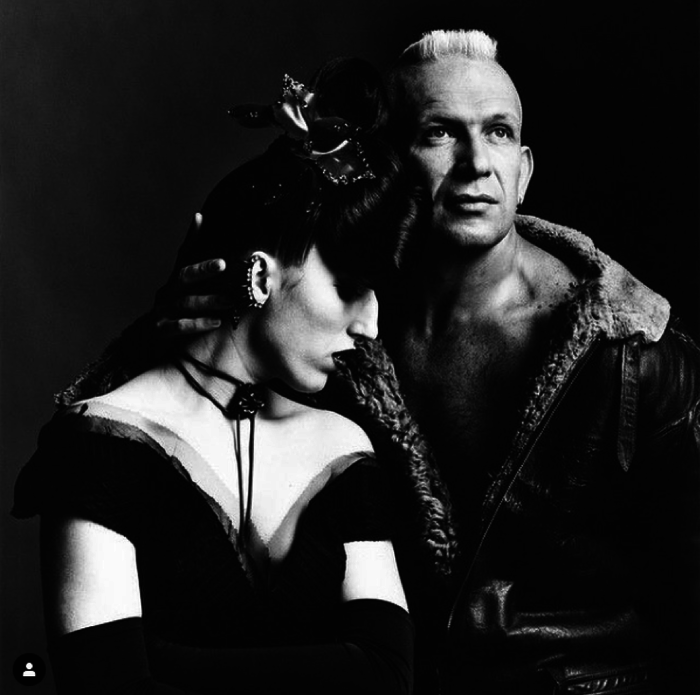The Guest Designer: A return to art in fashion
Pilar Eche Fernandez explores the rise of the guest designer in encouraging creativity and collaboration within the fashion industry
Jean Paul Gaultier will return to couture after announcing his retirement in January 2020. Fashion followers, however, might not be surprised with his return, as it technically doesn’t contradict the statement published by the designer on his Twitter account earlier this year: “This show celebrating 50 years of my career will also be my last. But rest assured Haute Couture will continue with a new concept.”
This new concept consists in having guest designers in charge of each new collection, season after season. The first of these guests will be Chitose Abe, designer of SACAI. This idea appears to be increasingly popular among designers, so it is worth considering its implications. In an interview alongside Miuccia Prada for System, Raf Simons expressed his desire of redefining the fashion industry on similar terms. His idea is to bring designers together in a fluid and interactive engagement, where collections are the work of guests who can each contribute to the overall image of a brand.
In a way, this system would bring fashion closer to its artistic and cultural essence and away from a commercialised understanding of clothing as a mere commodity. In the same interview, Miuccia Prada was asked about her opinion on the fact that fashion has become an industry and, as such, a sector defined by its commercial purpose, its need to sell, and its ambition to surpass competitors. The designer made an interesting comment that, by growing a fashion business, one loses control over it.
It’s particularly relevant to think about the issue of fashion becoming a consumer product and the subsequent loss of creative control over growing firms, when many of the biggest names in the sector are in fact just that, names. Names of the designers and founders who created their brands. Names that confer an identity to a maison. One cannot think of Chanel or Dior without Coco and Christian. However, these two examples have had six and seven creative directors respectively, after their founders’ deaths, and have still remained relevant in the industry.
Perhaps this is only sustainable if each creative director remains in the firm for a minimum period. The shortest for Chanel, for instance, was Gaston Berthelot as creative director from 1971 to 1973. But once this span shortens to the point that the creative force behind a collection is different each season, an area of uncertainty arises. To what extent can a collaborative fashion industry preserve the essence that characterises a brand? Can Gaultier’s alternating guest designers sustain the brand and afford it stability? What happens to identity once the subjectivity and creativity of different individuals impregnates a firm?
The answer might lie in a reconsidering of how we perceive fashion in terms of creation and art. Although it is true that a brand is originally connected to its creator, in fashion, as in other artistic sectors, the reworking of concepts, ideas and materials by different minds can expand the work of an individual person. In film, remakes can build on previous material to make it relevant. Little Women was presented to an audience in six cinematic versions before the 2019 movie. However, these different adaptations don’t detract from each other, since there is always something new to reflect on and a fresh perspective which meditates on an older work. It then becomes simply a matter of adjusting our representation of the original story to one that is relevant to a modern audience.
Similarly, we could reconsider fashion and redefine it as an art that can also be put in conversation with itself. Reworkings of a firm’s iconic pieces can appeal and engage us in new ways. The essence of a firm can be maintained so long as the dynamic collaboration among designers is always in contact with the past. In this model, creative directors would not completely transform a brand’s image, but would rather mould it and present it from alternative viewpoints, highlighting different aspects of its identity. As Raf Simons argues for System, “maybe fashion should operate more like a museum, where you have a museum curator, but you have guest curators come in, too.”
By drawing from archival ideas and reworking them from new perspectives it’s possible to maintain the public’s interest in a fashion brand which could otherwise become stagnant. We should then fully view fashion for the form of art it represents, one where iconic elements of a house’s style and identity can be curated and reshaped to produce an exhibition of all that fashion has to offer.
 News / Uni Scout and Guide Club affirms trans inclusion 12 December 2025
News / Uni Scout and Guide Club affirms trans inclusion 12 December 2025 News / Pembroke to convert listed office building into accom9 December 2025
News / Pembroke to convert listed office building into accom9 December 2025 Features / Searching for community in queer Cambridge10 December 2025
Features / Searching for community in queer Cambridge10 December 2025 News / Uni redundancy consultation ‘falls short of legal duties’, unions say6 December 2025
News / Uni redundancy consultation ‘falls short of legal duties’, unions say6 December 2025 Science / Did your ex trip on King’s Parade? The science behind the ‘ick’12 December 2025
Science / Did your ex trip on King’s Parade? The science behind the ‘ick’12 December 2025








